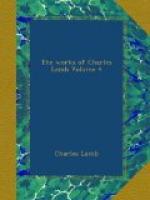“But, ah! what means the silent
tear?
Why, e’en ’mid
joy, my bosom heave?
Ye long-lost scenes, enchantments dear!
Lo! now I linger o’er
your grave.
“—Fly, then, ye hours
of rosy hue,
And bear away the bloom of
years!
And quick succeed, ye sickly crew
Of doubts and sorrows, pains
and fears!
“Still will I ponder Fate’s
unaltered plan,
Nor, tracing back the child, forget that
I am man."[1]
[Footnote 1: Lines meditated in the cloisters of Christ’s Hospital, in the “Poetics,” of Mr. George Dyer.]
* * * * *
ON THE TRAGEDIES OF SHAKSPEARE.
CONSIDERED WITH REFERENCE TO THEIR FITNESS FOR STAGE-REPRESENTATION.
Taking a turn the other day in the Abbey, I was struck with the affected attitude of a figure, which I do not remember to have seen before, and which upon examination proved to be a whole-length of the celebrated Mr. Garrick. Though I would not go so far with some good Catholics abroad as to shut players altogether out of consecrated ground, yet I own I was not a little scandalized at the introduction of theatrical airs and gestures into a place set apart to remind us of the saddest realities. Going nearer, I found inscribed under this harlequin figure the following lines:—
“To paint fair Nature, by divine
command
Her magic pencil in his glowing hand,
A Shakspeare rose; then, to expand his
fame
Wide o’er this breathing world,
a Garrick came.
Though sunk in death the forms the Poet
drew,
The Actor’s genius bade them breathe
anew;
Though, like the bard himself, in night
they lay,
Immortal Garrick called them back to day:
And till Eternity with power sublime
Shall mark the mortal hour of hoary Time,
Shakspeare and Garrick like twin-stars
shall shine,
And earth irradiate with a beam divine.”
It would be an insult to my readers’ understandings to attempt anything like a criticism on this farrago of false thoughts and nonsense. But the reflection it led me into was a kind of wonder, how, from the days of the actor here celebrated to our own, it should have been the fashion to compliment every performer in his turn, that has had the luck to please the Town in any of the great characters of Shakspeare, with the notion of possessing a mind congenial with the poet’s; how people should come thus unaccountably




